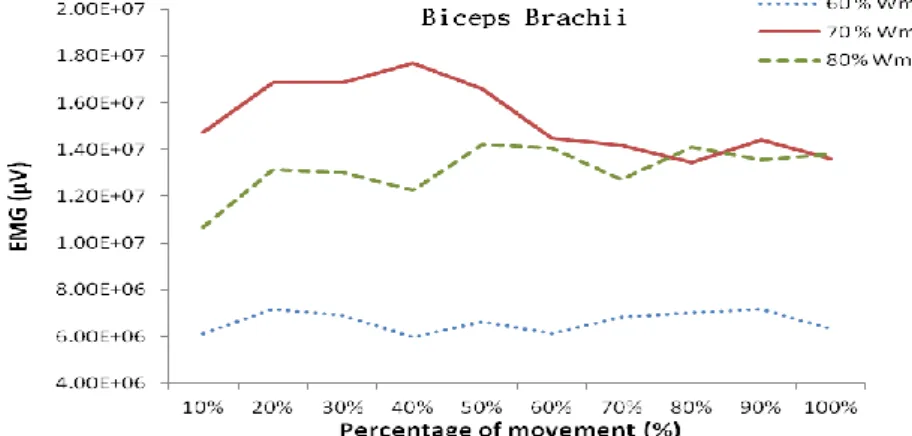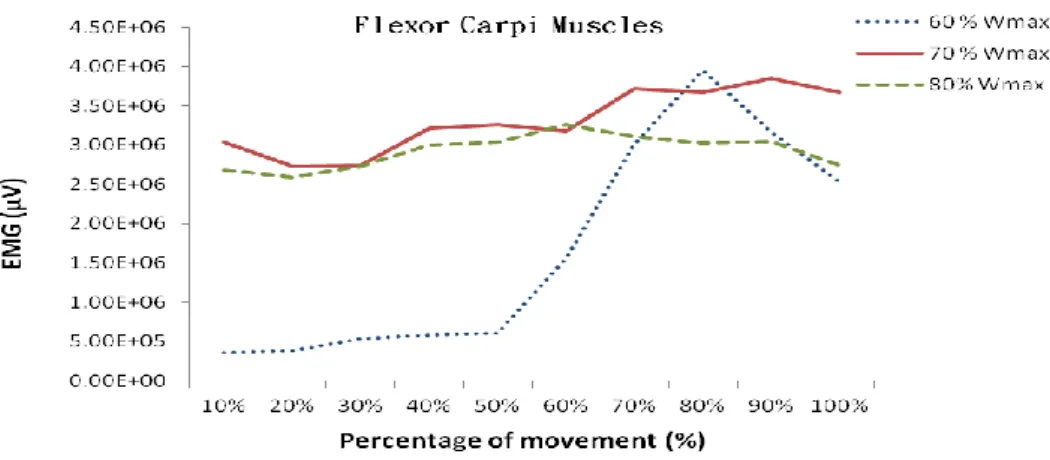THE PREDICTION OF FATIGUE-RELATED MUSCLE ADAPTATION IN
DIFFERENT WORKLOAD DURING CYCLING ROWING EXERCISE.
Wei-Hsien Hong*, Hui-Ju Wang, Kuei-Ru Chen, Mei-Hua Huang
Department of Sports Medicine, China Medical University, Taichung, Taiwan
The purpose of this study was to identify the fatigue-related muscles during the different percentage of the maximal workload. Seven subjects were recruited and, firstly, performed the maximal workload test for 3 minutes. After 24 hours, the different workload tests (60%, 70% and 80% of the maximal workload) were used to reveal the fatigue-related muscle. The result showed that the biceps and triceps had the extreme contribution at the minor and greater workload. However, the neuromuscular fatigue threshold (NFT) is to predict the possibly fatigue muscle condition during the entire exercise. And the most contribution of the EMG expression didn’t stand for the greater value of the EMG number.KEY WORDS: rowing, neuromuscular fatigue threshold, electromyography.
INTRODUCTION: The evaluation of sport performance is important to most of athletes,
especially based on several distinct elements, such as oxygen uptake (VO2), heart rate and muscle activity, but, undoubtedly and essentially, the biomechanical factors can also very much reflect the determinant of the rowing exercise [1]. It is inevitable that physical fatigue is fully perceived as the perplexing condition during training period [2] and thus the relationship between muscle fatigue and muscle activity can be referred to as the crucial factor to predict the athlete’s performance. In addition to that, rowing exercise has been viewed as an endurance training activity; the mechanism of fatigue during rowing is not fully investigated. This study is aimed at the identifying the fatigue-related muscles during the different degree of the rowing exercise.
METHODS: Seven college students were recruited and executed rowing exercise on a
rowing ergometer (Concept II, Concept Inc., Morrisville, VT). All of the subjects had no severe neuromuscular disease and without any muscloskeleton system disability. Furthermore, subjects’ muscle activities were recorded by electromyography (EMG) (SX230, BioMetrics Ltd., UK) which is supported by a portable data logger. The muscles involved in the rowing exercise testing, namely biceps brachii, triceps, flexor/extensor carpi muscle (FC/EC), latissimus dorsi (LD), erector spinae (ES) were included for EMG evaluation. Speaking of maximal exhaustion test, subjects were first asked to row at the maximal power output (Watt) to exhaustion within 3 minutes. After 24 hours later, subjects underwent rowing tests at 60%, 70% and 80% of maximal power output respectively in different days. On the day of test, work load was gradually increased to desired level and EMG signals were recorded immediately. EMG variables (mean value), was sampled at 1000Hz and analyzed by the self-developed MATLAB program. As to the neuromuscular fatigue threshold (NFT), the 10-110Hz Band Pass Filter was used to initially analyze the data recorded form data logger. Then, we established the Root Mean Square to obtain the muscles’ activities during the exercise [3].
RESULTS: The mean value of the electromyography (EMG) was illustrated in Figure 1,
meaning that the contribution of biceps brachi were approximately 27%, 19% and 12% of the maximal voluntary contraction (MVC) at 60%, 70% and 80% of maximal power output (W) respectively. Logically, the triceps remained incremental accompanied with the increasing workload, namely, 7%, 10% and 20% MVC at 60%, 70% and 80% of maximal power output (W) respectively. However, FC/EC, LD, and ES muscles remained constant among different workloads, which ranged from 11%-15%.
Figure 1. Muscle activity contribution among every muscle.
Second of all, the neuromuscular fatigue threshold (NFT) results showed in the Figure 2 to Figure 4, in which the significant tendency of the active muscle was analyzed in order to predict the fatigue-related muscle [3]. By general, the value of the EMG (μV) of the biceps brachii, to some degree, was higher than others’ muscle ranged from 6.12 x106 to 1.77 x107 (μV). And the flexor carpi muscles had the relatively higher value (3.91 x106 to 1.63 x107 (μV)) as compared to the triceps muscle (3.59 x105 to 3.95 x106 (μV)).
Figure 2. The neuromuscular fatigue threshold (NFT) of biceps brachii.
Figure 4. The neuromuscular fatigue threshold (NFT) of flexor carpi muscles.
DISCUSSION: The mean value of the EMG revealed some indications as to muscle
contribution during the entire rowing exercise, meaning that the biceps brachii and the triceps, as the agonist and antagonist muscle, logically represented the reasonable pattern - when the workload increased, they had the opposite reaction. As we know, the rowing exercise ergometer is a machine which needs most contribution of the arm motion [4]. In light of this, the biceps brachii occupied relatively higher contribution during the exercise at the 60% of the maximal workload. However, the antagonist muscle, triceps, played the crucial role at the 80% of the maximal workload. Besides, other muscles remained constant contribution among every maximal workload.
The neuromuscular fatigue threshold (NFT) [3] was used to predict the fatigue-related muscle condition. However, form the logical point of view, NFT had the opposite results as compared to former results of this study. Biceps brachii had the relatively higher contribution than triceps did at the 80% of the maximal workload. But, the triceps had the most contribution at 80% of the maximal workload. It could logically explain by a concept, most contribution of the active muscle doesn’t stand for the great value of the EMG expression. However, the constant muscle distribution of triceps at 80% of the maximal workload maybe claimed one issue – continuous activation of muscle during the entire exercise. In that our subjects were not the professional rowing athletes, the uneven distribution of the muscle activities could be argued by unfamiliar with the motion of the rowing exercise.
CONCLUSIONS: The biceps brachii at the 60% and briceps brachii at the 80% of the
maximal workload played the crucial roles, and other muscles remained constant contribution among every maximal workload. Understanding the order of the muscle fatigue during rowing can prevent the risk of injury, and enhance training by an exercise prescription design.
REFERENCES:
[1] Turpin NA, Guevel A, Durand S, and Hug F (2011). Effect of power output on muscle coordination during rowing. Eur J Appl Physiol 111(12):3017-29.
[2 Rivera AR, Wyneken J, and Blob RW (2011). Forelimb kinematics and motor patterns of swimming loggerhead sea turtles (Caretta caretta): are motor patterns conserved in the evolution of new locomotor strategies? J Exp Biol 214(Pt19):3314-23.
[3] Ezequiel Moreira Gonçalves et al, (2010). Neuromuscular fatigue threshold, critical power and anaerobic work capacity under caffeine ingestion. Int SportMed J 11(4):380-8.
[4] Alison SA, Richard MS, and Peter JS. (2012). Effect of gender and stroke rate on joint power characteristics of the upper extremity during simulated rowing. J Sports Sci 30(5):449-58. Acknowledgement
This study was supported by a grant from the National Science Council, Taiwan. (No. NSC101-2221-E-039-001-).

